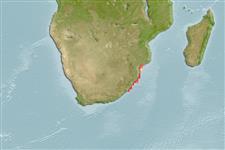>
Clupeiformes (Herrings) >
Ehiravidae (River sprats)
Etymology: Gilchristella: Because of John Gilchrist, father of the South African ichthyology; Cape Town, 1925.
Eponymy: Dr John Dow Fisher Gilchrist (1866–1926) was a Scottish-born South African ichthyologist and naturalist. [...] Dr John Dow Fisher Gilchrist (1866–1926) was a Scottish-born South African ichthyologist and naturalist. [...] (Ref. 128868), visit book page.
Environment: milieu / climate zone / depth range / distribution range
Ekologi
laut; air tawar; payau; amphidromus. Subtropical; 25°S - 36°S, 17°E - 34°E (Ref. 188)
Africa: Lake Piti, Mozambique, along south and east coasts of South Africa to Saldanha Bay (Ref. 188, 3509), and as far north as the Olifants River on the west coast (Ref. 7248), possibly to mouth of Orange River (Ref. 188, 3259). Also reported from Madagascar (Ref. 3509, 13333), but its presence is not confirmed; it is probably based on confusion with Sauvagella madagascariensis, while Gilchristella aestuaria does not occur in Madagascar (Ref. 33664). Reported occurrence in India (Ref. 32693) is of dubious validity (Ref. 33664). Currently a single species, but at least two forms, possibly different species, are known (Ref. 52193).
Length at first maturity / Size / Weight / umur
Maturity: Lm 2.8, range 2 - 3 cm
Max length : 9.0 cm SL jantan/; (Ref. 52193); Umur maksimum dilaporkan: 6 Tahun (Ref. 7248)
deskripsi pendek
Kunci identifiaksi (pengenalan) | Morfologi | Morfometrik
Duri punggung (Keseluruhan (total)) : 0; duri punggung lunak (Keseluruhan (total)) : 14 - 15; Duri dubur: 0; Sirip dubur lunak: 20. Diagnosis: Body rather compressed, belly rounded, with 6 to 9 thin unkeeled pre-pelvic scutes followed by an equally thin pelvic scute, all with slender ascending arms; no post-pelvic scutes; snout pointed, lower jaw a little prominent, with a single row of fine teeth in each jaw; posterior supra-maxilla paddle-shaped; gillrakers 39 to 76, gillrakers small but present on posterior face of third epibranchial; pelvic fin with i-7 finrays, under or a little before dorsal fin origin (Ref. 188). Resembles Spratelloides species or juvenile Etrumeus and Dussumieria, but pre-pelvic scutes present; other clupeids occuring in same area have keeled pre-pelvic and post-pelvic scutes (Ref. 188).
Occurs in the sea, but found mostly in estuaries; also found in landlocked brackish and freshwater lagoons (Ref. 93596), also rivers and lakes (Ref. 188). Maximum size 10 cm (Ref. 4967). Entire life cycle is completed in the estuary (Ref. 32693). Breeds throughout the year with a peak in spring and early summer (Ref. 7248, 52193). Maturity may be attained within the first or second year and an age of up to 5 or 6 years is recorded (Ref. 7248, 52193). Feeds chiefly on zooplankton by filtering or selecting individual organisms from the water column (Ref. 7248, 52193). It can tolerate salinities under 4 ppt and of up to 52.6 ppt (Ref. 32693). Utilized fresh or dried and salted (Ref. 12484).
A semelparous species that grows to maturity and spawns in one year (Ref. 34361).
Skelton, P.H., 1993. A complete guide to the freshwater fishes of southern Africa. Southern Book Publishers. 388 p. (Ref. 7248)
Status IUCN Red List (Ref. 130435: Version 2024-2)
ancaman kepada manusia
Harmless
penggunaan manusia
Perikanan: perikanan swasembada; umpan: usually
Alat, peralatan
laporan khas
muat turun XML
Sumber internet
Estimates based on models
Phylogenetic diversity index (Ref.
82804): PD
50 = 1.0000 [Uniqueness, from 0.5 = low to 2.0 = high].
Bayesian length-weight: a=0.00955 (0.00474 - 0.01922), b=3.06 (2.88 - 3.24), in cm total length, based on LWR estimates for this species & (Sub)family-body (Ref.
93245).
Trophic level (Ref.
69278): 3.1 ±0.3 se; based on size and trophs of closest relatives
Daya lenting (Ref.
120179): Tinggi, Waktu penggandaan populasi minimum kurang dari 15 bulan (tm=0.5).
Fishing Vulnerability (Ref.
59153): Low vulnerability (10 of 100).
